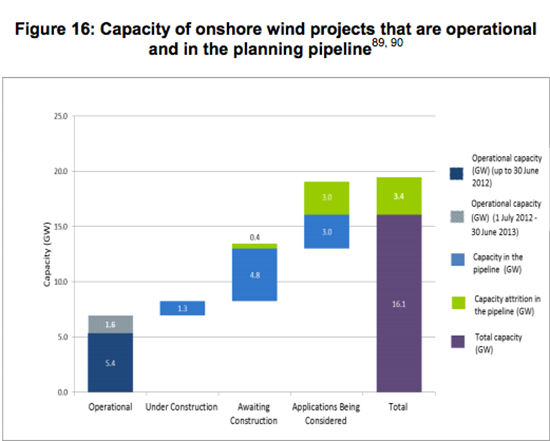Subsidies for windfarms cost every household £25 a year, according to the Daily Mail today. Government figures show the Mail’s calculation is an overestimate, however.
Conservative MP Stephen O’Brien has been asking a series of parliamentary questions about the cost of wind power. The Mail appears to have based its claim that windfarms add £25 to household bills on one of energy minister Michael Fallon’s answers, which gives a figure for the total cost of supporting windfarms in the UK.
But the Mail need not have tried to do the maths. In another question, O’Brien asks directly how much windfarms add to consumer energy bills. Fallon answers the government estimates that cost is £18 – £7 lower than the Mail’s calculation. We look at why.
The Mail’s calculation
The government supports the development of the windfarm industry through a subsidy known as the Renewables Obligation (RO). Support for onshore wind through the RO cost £557 million last year, and offshore wind cost £669 million. So all in all, support for windfarms through the RO cost £1.2 billion last year, according to Fallon’s answer.
The costs of the RO is added to consumer energy bills. If the £1.2 billion was divvied up among the 26.4 million households in the UK, every household would pay about £48.
Domestic households don’t bear all of the costs, however, because industry and businesses also pay electricity bills – and therefore also pay for the RO. To account for this, Mail appears to have divided the total cost of the RO (roughly) by half, and then divided that figure up by the number of homes in the country. As a result, it calculates that every household in the country pays out £25 in support for windfarms, via that RO.
The Mail has bumped the figure up…
The Mail’s complicated calculation wasn’t really necessary, however – because Fallon has answered the question of how much money support for onshore and offshore adds to energy bills in another statement, issued a few days later.
Fallon says support for onshore and offshore wind through the RO each add about £9 of the average energy bill – or £18 in total. Trade body Renewable UK tells us it agrees the right figure is £17 or £18. Support for small-scale wind, via Feed in Tariffs, also adds a small amount – less than £1.
The Mail’s figure is probably an overestimate because domestic consumers account for about a third (36 per cent) of electricity supply, not half. So it probably makes more sense to divide the total £1.2 billion cost by a factor of three, in order to work out how much cost each household bears.
…but the figure is going up
The Mail is right that the cost of subsidising windfarms is increasing, however. The government is attempting to meet a European target to source 15 per cent of the country’s energy from renewable sources by 2020. As a result, the country’s windfarms are rapidly expanding at the moment.
In the graph below, the bar on the far left shows the amount of onshore wind capacity in the UK in the middle of 2013. The bar on the far right shows what it could expand to by the end of the decade – from seven Gigawatts (GW) last year to 19.5GW in 2020:
Source: UK renewable energy roadmap, update 2013. Published by DECC on 5 November 2013.
The government has even greater ambitions for offshore wind – a technology that’s currently at an earlier state of development, and so has further to go. In the graph below, the bar on the far left shows the amount of offshore wind capacity in the UK in mid 2013. The bar on the far right shows how this may expand over the next few years – from 3.5GW last year to 15.5GW in 2020:
Source: UK renewable energy roadmap, update 2013. Published by DECC on 5 November 2013.
As the amount of windfarms in the country increases, the cost of subsidies is likely to grow as well.
But this trend may not last forever. The idea of the subsidies is they help young technologies through the early stages of their development. So as windpower expands in the UK, the cost of the subsidies per megawatt hour of electricity produced is also likely to come down.
To illustrate this, the government has ambitions to radically reduce the cost of offshore wind by 2020; and is already in the process of reducing subsidies for onshore wind.
Windpower is likely to have other impacts as well – for example lowering the wholesale cost of electricity by introducing new source of energy onto the grid. But in the short term, subsidies for windfarms is likely to remain a source of controversy – as long as opposition to windfarms exists.



